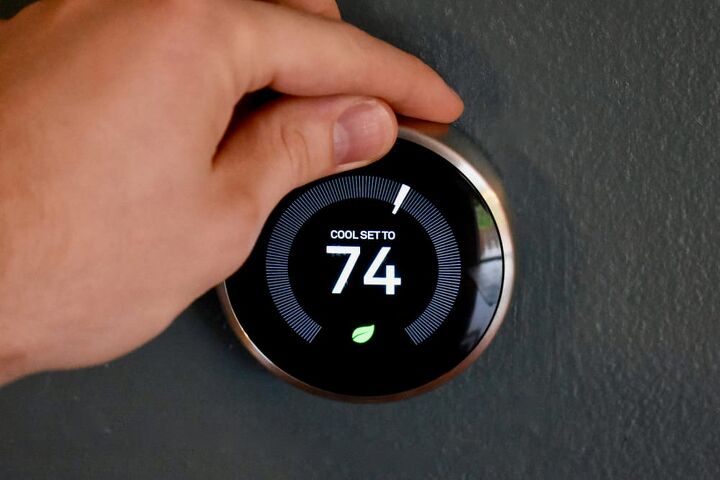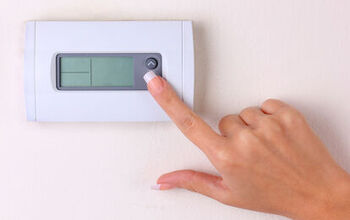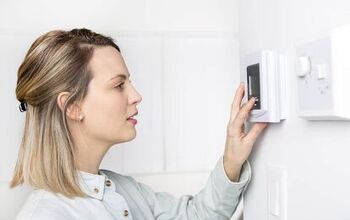Room Temperature Doesn't Match The Thermostat Setting?

Thermostats are remarkable if you think about it. That little box can make your home feel as warm or as cool as you want it to. Of course, this is only true if your room temperature actually matches what you set your thermostat to. If it doesn’t match, it doesn’t work. So, how can you fix this issue?
Your room temperature won’t match the thermostat setting if your air filters are dirty. Frayed wiring, corrosion, and dust inside of the thermostat can keep it from working correctly. Replace your thermostat if it is 15 years or older if it cannot bring a room up to the right temperature.
Understanding the many different issues that you may have with the thermostat in question can help you figure out your next steps. This guide will give you a full walkthrough of what you should know and how to address this issue.
Do You Need Your Thermostat Repaired or Reprogrammed?
Get free, zero-commitment quotes from pro contractors near you.

Before You Begin: Is It Really A Temperature Mismatch?
It’s important to understand the way that thermostats work. Thermostats read the temperature in and around the box. This means that the placement can impact your thermostat’s temperature. Here’s what you can do to make sure that there’s actually a problem afoot:
- Tape a thermometer next to the thermostat. If it reads within a single degree, then you have matching temperatures.
- Check to see if your thermostat is level and installed correctly. Your thermostat shouldn’t be crooked, as this can actually impact the way that your thermostat reads temperatures.
- Get the thermostat out of direct sunlight. Yes, sunlight can damage your thermostat’s ability to detect temperature.
- Give your thermostat time to work. It can take up to an hour or so to get your room to be the same temperature as your thermostat control.
Get Your Thermostat’s Owner’s Manual
Before you even think about tinkering with your thermostat, make sure to grab a copy of your owner’s manual. Your owner’s manual will give you information on how to fix your thermostat, how to open it up, as well as other issues that may arise during troubleshooting. When you look at our troubleshooting guide, refer to your manual to get instructions specific to your model.
If you don’t know your thermostat model, take a look at any numbers or names you found on your thermostat. Then, search the model up online. You will be able to find an owner’s guide on one site or another.
Check Your HVAC Filters First!
HVAC filters are there to help ensure that the air you get is clean and safe to inhale. Unfortunately, they can trap enough dust to “muffle” your furnace’s ability to send over hot air. If you haven’t cleaned or replaced your furnace filters, do so and give your home some time to readjust. Chances are, you’ll notice the thermostat and temperature matching up soon enough.
There’s a fairly good chance that the thermostat readings are off as a result of a lack of airflow in your HVAC system. If you have ascertained that the furnace or AC filters are not the cause of the problem, it’s time to check your thermostat.
Troubleshooting Your Thermostat
If you’ve checked everything and you’re sure that there is a temperature difference between your thermostat’s commands and the room, it’s time to get into troubleshooting. When reading this, make sure to refer to your guide to walk you through some of these steps on a more specific level.
Generally speaking, most thermostats will be able to respond to the troubleshooting outlined below. So, here’s how you can fix most of the common issues that you might be running into:
- Start by checking to see if your thermostat has power. If you see a “LOW BATTERY” light, don’t see any power being sent to it, or can’t turn it on, address this by changing your thermostat’s batteries and making sure that your circuit breaker isn’t tripped.
- If that doesn’t fix the issue, turn it off and remove your thermostat from the wall. Open up your thermostat per the instructions and check to see the quality of the inside of your thermostat.
- Clean the inside of your thermostat. Most dust and grit can be removed with a gentle brushing. This will help ensure that your sensors will be able to pick up on any temperature changes more accurately.
- Check for and remove any corroded equipment you see. If you see severe corrosion, you will need to replace your thermostat. If the corrosion is light, you might be able to get rid of it by using a gentle electronic contact cleaner.
- While you’re at it, you might want to check the wiring to make sure that none of it is frayed. Frayed wiring is a sign that you need to replace your thermostat.
- Tighten up any loose screws or mis-installed parts. This will help ensure that any issues caused by a poorly-assembled thermostat will be a thing of the past.
- Once the thermostat is clean, replace it on the wall and turn it on. Make sure that the thermostat is set to the right temperature and wait to see if your work fixed it. If you have any settings that may have changed, make sure to do a reset before you assume it’s not fixable.
- If all else fails, you might want to contact your thermostat’s maker to get some assistance. If they cannot find any issue with the thermostat, call an HVAC tech. You might have a more complex problem that needs to be addressed with your HVAC system.
When Should You Replace Your Thermostat?
For the most part, thermostats are fairly durable and should be able to last 10 to 15 years. If you can’t get your thermostat to function accurately or if you have an issue that is not fixable with your thermostat, you will probably need to replace it. If you’ve been struggling with getting your thermostat to behave normally for a while, it might also be a good idea to get a new one.
How Much Does A New Thermostat Cost?
This all depends on how many bells and whistles you want in your thermostat. Basic modern thermostats will start at around $25 for an electric model that has few features. If you want to get a smart thermostat from a brand name, then you might pay as much as $195 or more.
If you want to pay someone to install a new thermostat in your home, then you can expect to pay an additional $50 to $100 in labor costs. Thankfully, some companies will allow you to make the most of your call by bundling the parts and labor together. It’s a relatively quick fix, too.
Do You Need To Hire Someone To Replace Your Thermostat?
For the most part, this seems to be a matter of personal preference. If you feel comfortable replacing your own thermostat and doing a full install, then you can do it on your own. There are plenty of guides online that show you how it can be done, step by step. You’ll just need to get the right tools for the job.
With that said, most people prefer to hire someone else to install a thermostat. If you’re not comfortable with electrical work, you might want to hire a pro. There’s no shame in asking for a little help, and it’s better to make sure that you’re safe rather than sorry.
Do You Need Your Thermostat Repaired or Reprogrammed?
Get free, zero-commitment quotes from pro contractors near you.

Related Questions
Why isn’t my thermostat getting any power?
There are plenty of reasons why a thermostat may not be getting any power. Assuming that it has not run out of batteries, you should check to see if your circuit breaker has tripped. If it has, then that’s why your thermostat has no power. Otherwise, there is a chance that your thermostat has electrical problems that impede its ability to get power. Improper installation can do this.In very rare cases, a thermostat that just won’t turn on may be a victim of a total electrical failure. If this is the case, your thermostat is a “dud” and needs to be replaced.
Why won’t my home’s HVAC system turn on?
If you woke up to a very chilly morning today, only to find that your HVAC won’t turn on, then you probably are dealing with a thermostat problem. Your thermostat is what regulates temperature in your home. If you can’t get your thermostat to match the temperature of the room or notice that you keep getting error messages, it’s time to do some troubleshooting.
Are wi-fi thermostats worth the money?
Most experts agree that wi-fi is well worth the money. Using a wi-fi thermostat will reduce cooling and heating bills by anywhere from 10 to 20 percent per year. That means that your wi-fi thermostat will eventually pay for itself. If you ask us, that’s a pretty good testament to its value.Moreover, some areas will give you a tax credit for having a thermostat that’s considered to be “eco-friendly.” So it’s definitely a win-win for mother nature and your bills.

Ossiana Tepfenhart is an expert writer, focusing on interior design and general home tips. Writing is her life, and it's what she does best. Her interests include art and real estate investments.
More by Ossiana Tepfenhart












![The 5 Best Angle Grinders – [2022 Reviews & Buyer's Guide]](https://cdn-fastly.upgradedhome.com/media/2023/07/31/9071326/the-5-best-angle-grinders-2022-reviews-buyer-s-guide.jpg?size=350x220)

![10 Best Electric Lawn Mowers - [2022 Reviews & Top Rated Models]](https://cdn-fastly.upgradedhome.com/media/2023/07/31/9070486/10-best-electric-lawn-mowers-2022-reviews-top-rated-models.jpg?size=350x220)












